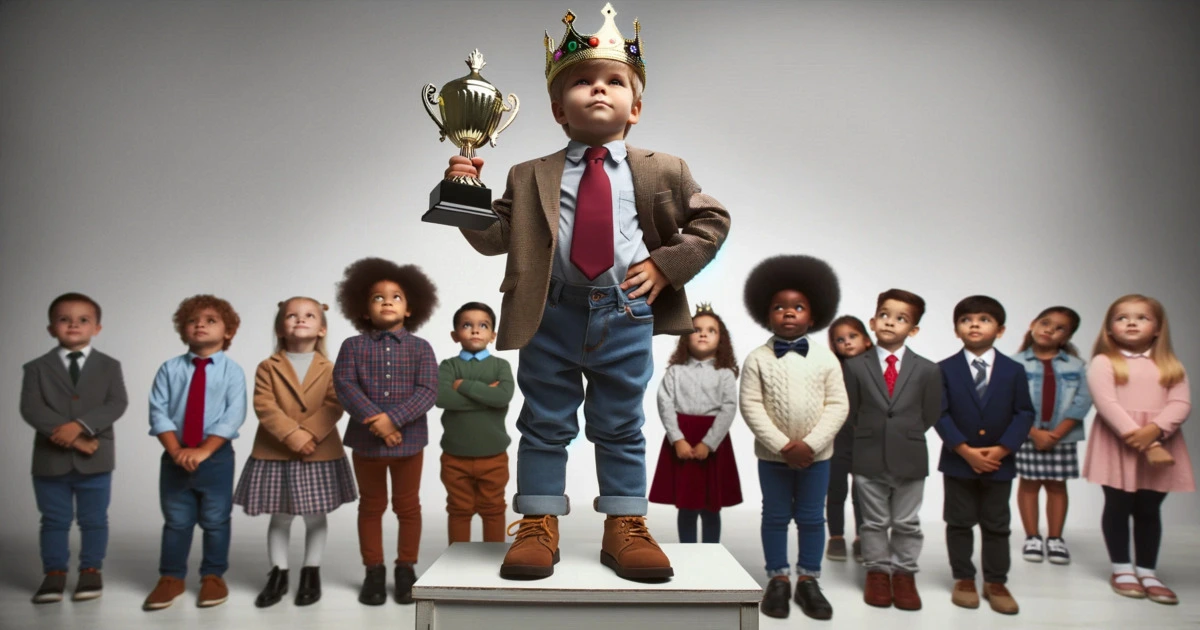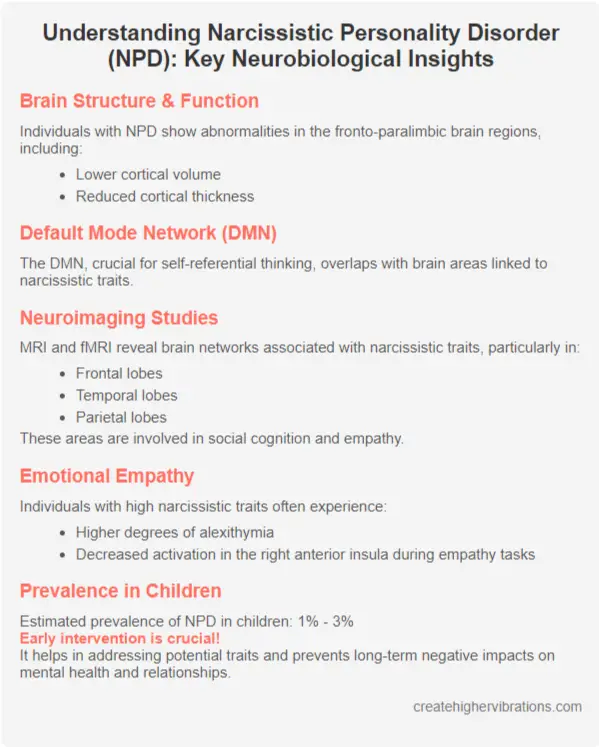Narcissistic Personality Disorder Traits In Children: A Revealing Scary Truth!

Have you wondered about what narcissistic personality disorder traits in children may look like? Picture this: a family sitting around a dinner table, laughing and sharing the day’s stories. The youngest child, barely 12, sits quietly, absorbing the attention but never contributing to the conversation.
Over time, a subtle change occurs; the child begins to dominate discussions, dismisses the opinions of others, and increasingly lacks empathy. What began as mere child’s play starts to resemble something far more complex.
So, what is going on here? Is this typical childhood behavior, or are we witnessing the early signs of Narcissistic Personality Disorder (NPD)? More importantly, if it is the latter, what can the family do about it?
When I think about this, I find myself contemplating the thin line between nurturing self-esteem in our young ones and sowing the seeds of narcissism. What are the signs that separate a confident child from a narcissistic one? These are questions that I believe every parent, guardian, or caregiver should ponder deeply.
General Symptoms of Narcissistic Personality Disorder Traits in Children
When we discuss Narcissistic Personality Disorder (NPD), our thoughts often drift toward portrayals in popular culture—characters who are self-absorbed and crave admiration. But let’s delve deeper: what truly constitutes NPD? Is it just an inflated sense of self-importance, or is there more beneath the surface?
In my years of practice and study, I’ve observed that narcissism isn’t merely about an excessive love of oneself. It’s a complex mental health condition that manifests in a variety of symptoms. One might see traits like arrogance, a sense of entitlement, and even a certain level of manipulative behavior.
At the core, there’s often an overwhelming need for admiration and a lack of empathy for others. Yet, it’s not as straightforward as ticking off a checklist. People with NPD often experience intense emotional fluctuations, particularly when they don’t receive the attention or admiration they feel they deserve.
Now, it’s crucial to understand that children, like adults, can display these symptoms. But, is it fair to label them at such a tender age? As a child navigates through the various stages of development, it’s normal to exhibit self-centered behavior.
However, when these traits persist into adolescence, it might be time to consider a deeper evaluation. The challenge lies in distinguishing between what is a ‘phase’ and what could potentially be a lifelong pattern.

Here are some symptoms you might observe in children who could be developing narcissistic traits:
Now, it’s crucial to recognize that children are still in the developmental stage. It’s not uncommon for them to go through phases where they exhibit some of these behaviors. I often ask parents: “Is it a fleeting moment or a consistent pattern?” That question becomes the cornerstone for deciding whether professional intervention is warranted.
narcissistic child symptoms
As we venture further into understanding NPD, it’s crucial to zoom in on the nuances that differentiate children from adults in this context. You see, while certain indicators of narcissism may be universal, the manifestation in young minds has its own set of unique attributes.
Here’s a list of signs that are particularly relevant when assessing NPD in children:
When I contemplate these indicators, it raises an intriguing question: How do these signs interact with a child’s developmental stages? Could the excessive tantrums be a mere expression of a phase, or do they hint at deeper emotional challenges?
Such questions guide us in differentiating between temporary behaviors and potential long-term personality traits.
Causes of Narcissism in Children
When evaluating narcissistic personality disorder in children, it’s valuable to pinpoint the specific factors that contribute to the development of such traits. Let’s not merely scratch the surface; let’s dig deeper to unearth the underlying causes. Here’s a list of contributing factors:
I often find myself asking: How can we disentangle the complex web of factors to arrive at a solution? It’s essential to recognize that these factors often work in synergy, creating a multi-faceted and deeply-rooted issue.
As we move forward, we’ll delve into how parents can play a proactive role in shaping their children’s personalities for the better.

How Parents Create Narcissistic Children: A Double-Edged Sword
As we probe deeper into the children of the self-absorbed, it’s impossible to overlook the role of the first heroes in a child’s life—the parents. Yes, the people who are meant to nurture can sometimes end up sowing the seeds of narcissism. But how exactly does this transpire?
In my experience, parents often become inadvertent sculptors of their children’s narcissistic traits. For instance, when caregivers continuously place a child on a pedestal, it can instill in the young mind an inflated sense of self-worth.
It’s like constantly feeding a child sugar and then wondering why they’re hyperactive. On the flip side, emotional neglect can produce similar results. A child starved for attention may develop narcissistic traits as a defense mechanism, a sort of emotional armor.
While it’s natural for parents to want the best for their offspring, one must ponder: At what point does ‘wanting the best’ transform into ‘wanting them to be the best at everything’? This kind of pressure can be a heavy burden for a child, leading them to adopt a narcissistic lens through which they view the world.
After all, children aren’t merely vessels to be filled with expectations; they’re unique individuals who need the space to develop their sense of self.
Treatment
As we navigate the intricate pathways of children’s mental landscapes, we must consider the road to recovery. A diagnosis of Narcissistic Personality Disorder traits in a child can be a jolt for any family, but it’s far from a dead end.
What treatment options can guide these young souls back to a more balanced state of being?
Therapy is often the cornerstone of effective treatment. Cognitive Behavioral Therapy (CBT) can give children the tools to better understand their thought patterns and emotions.
Essentially, it teaches them to be their emotional cartographers, mapping out their feelings and learning to take different routes to avoid the pitfalls of narcissism.
Another avenue for intervention is family therapy. The family unit is like the soil in which a child’s personality grows; thus, enriching that soil can bring about profound changes. Involving the family in therapy can ensure that the home environment is conducive to positive behavioral change.
Mindfulness practices, though not a replacement for professional treatment, can supplement these therapies effectively. From personal observation, mindfulness can help children become aware of their thoughts and actions in real time, allowing for self-correction before a narcissistic impulse turns into a narcissistic action.
So, as we stand at this juncture, it might be worth asking ourselves: Are we equipped to walk this healing path with our children? The journey may be arduous, but the destination—a balanced and empathetic individual—is surely worth the trials.
Narcissistic Traits in Children: Early Intervention and Its Lifelong Impact
Narcissistic Personality Disorder (NPD) might not be the first thing that comes to mind, but understanding the signs early on could make a world of difference.
This article dives deep into how early intervention can shape a child’s emotional landscape and set them on a path toward healthier relationships and a more balanced life.
How NPD Traits Manifest in Children
The human brain is incredibly complex, and when it comes to narcissistic traits, science is just beginning to scratch the surface.
Research shows that certain brain regions in children displaying narcissistic tendencies don’t function the same way as in their peers.
These areas, particularly in the fronto-paralimbic region, are involved in emotional processing and self-awareness. But what does this mean for your child?
Imagine your child’s brain as a puzzle. Most pieces fit together perfectly, but a few key areas—the ones responsible for empathy and social cognition—don’t quite click into place.
This can result in behaviors that seem cold or self-centered, and without guidance, these traits could solidify into more problematic patterns.
The Role of the Default Mode Network (DMN)
Let’s talk about the Default Mode Network (DMN). Think of it as the brain’s autopilot mode, responsible for those moments when your mind wanders or when you reflect on yourself.
For children with narcissistic tendencies, this network might be overactive, leading to a constant focus on themselves. It’s not just daydreaming—it’s an ingrained way of thinking that shapes how they see the world and interact with others.
Now, this doesn’t mean your child is destined to become a narcissist. However, it does highlight the importance of teaching them to step out of this self-referential loop.
Encouraging activities that promote empathy, like volunteering or simply talking about other people’s feelings, can help them balance their inner world with the reality around them.

Why Your Child Struggles to Connect
Have you noticed your child having a hard time understanding or caring about how others feel? This could be more than just a phase.
Studies suggest that children with narcissistic traits often show reduced activation in the brain regions responsible for empathy. This isn’t something they can easily control—it’s a fundamental part of how their brain is wired.
But here’s the good news: the brain is remarkably adaptable, especially in young children. By fostering an environment where empathy is valued and modeled, you can help your child strengthen these neural connections.
Simple practices, like discussing feelings during family time or role-playing different scenarios, can make a big difference.
The Language of Narcissism: What Your Child’s Words Reveal
You might not realize it, but the way your child talks could be a window into their emotional world.
Children with grandiose narcissistic traits often use language that’s self-promoting or impulsive, while those with more vulnerable traits might be more defensive or emotionally reactive.
Pay attention to how your child communicates—it could offer clues about what’s going on beneath the surface.
For example, if your child constantly talks about their achievements or seems obsessed with being the best, this could be a sign of grandiosity.
On the other hand, if they frequently react with anger or hurt when criticized, this might point to more vulnerable narcissistic tendencies.
Understanding these patterns can help you tailor your approach, whether it’s reinforcing positive behaviors or gently addressing negative ones.
The Importance of Early Intervention
So, why is it so important to address these issues early on? Because the longer these traits go unchecked, the harder they are to change. Early intervention isn’t about labeling your child; it’s about giving them the tools to navigate their emotions and relationships healthy way.
Interventions can be as simple as setting clear boundaries and consistently reinforcing them. Children with narcissistic traits often struggle with rules and limits, so it’s crucial to be firm yet loving in your approach.
Encourage activities that promote cooperation and empathy, like team sports or group projects, where your child can learn to value others’ contributions.
Therapy can also be incredibly beneficial, not just for the child but for the whole family. A mental health professional can offer strategies tailored to your child’s needs, helping them develop healthier patterns of thinking and behavior.
What You Can Do at Home
Addressing narcissistic traits in children isn’t just about preventing a disorder—it’s about nurturing a well-rounded, empathetic, and emotionally healthy individual.
Recognizing the signs early and taking proactive steps can help your child develop into someone who values others as much as themselves. Remember, every small step you take today can impact your child’s future relationships and well-being.
Can Children Grow Out Of Narcissism
As children grow and develop, many parents and experts wonder if narcissistic traits naturally fade with age. Let’s explore what research tells us about this important topic.
A key study by Wetzel and colleagues found that narcissism tends to decrease as young people mature. Their research showed that levels of narcissism, vanity, and entitlement generally go down over time.
This matches what we know about how people mature – as kids get older, they usually become more caring towards others and less focused on themselves.
Dr. Eddie Brummelman, a developmental psychologist, explains:
“Narcissism peaks in adolescence and then decreases throughout adulthood. This decline is part of a broader pattern of personality maturation.”
However, it’s not always a smooth journey. The teenage years can see a rise in narcissistic behaviors before they start to drop off. Dr. Jean Twenge, a psychology professor, notes:
“There’s often a spike in narcissism during the teen years, which makes sense given the self-focus of adolescence. But for most people, those levels come back down as they enter adulthood.”
So what helps children grow out of narcissistic tendencies? Experts point to a few key factors:
It’s important to note that while most kids will naturally become less narcissistic with age, some may need extra support. Dr. Craig Malkin, a clinical psychologist, advises:
“If narcissistic traits persist or worsen into the late teens and early twenties, it might be time to seek professional help. Early intervention can make a big difference.”
Parents can also play a role in helping their children develop a healthy sense of self. Praising effort over innate talent, encouraging empathy, and modeling humble behavior can all contribute to balanced emotional growth.
While signs of narcissism in a child are common in childhood and may peak in adolescence, most young people do grow out of them as they mature. With the right support and experiences, children can develop into empathetic, well-adjusted adults.
Takeaway
As we conclude this in-depth exploration of the narcissist family tree, let’s take a moment to reflect. We’ve journeyed through the intricate dynamics of Narcissistic Personality Disorder traits in children, diving into symptoms, causes, and potential treatments.
But where do we go from here? What proactive steps can parents and caregivers take to ensure a healthier mental landscape for their young ones?
I believe the key lies in awareness and intentional action. Parents need to be keen observers, capable of recognizing early signs and intervening with love and firmness. Parents also need to be able to self-reflect on how their parenting style could be creating a narcissist.
Treatments like Cognitive Behavioral Therapy and family counseling can serve as crucial roadmaps, guiding us through the maze of complex emotions and behaviors.
Mindfulness, too, should not be overlooked as a supplementary practice. It’s not merely about identifying the problem; it’s about engaging in a holistic solution that involves the child, the family, and sometimes even the broader community.
So, as you stand at this crossroad, ask yourself: Are you willing to take the journey towards healing and balance? It’s a path that requires dedication, yes, but it’s a path that leads to a more harmonious life for your child—and for you.
The story doesn’t have to end at diagnosis; in many ways, that’s where it truly begins.
Namaste 🙂








